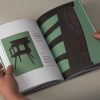Chair pairs – E-book
6.500 HUF
Contemporary chair studies by architecture uncomfortable workshop based on the collection of the Museum of Ethnography.
Zsófia Frazon
Chairs in the Museum: Character, Habit, Function
Beyond its aesthetic dimension, museum presentation—the act of placing artefacts in exhibition spaces to create interpretation—testifies first and foremost to how researchers and curators view culture, the museum, and the artefact as concepts. To display—to translate thoughts into spatial and visual language—is to render all of the above visible within the realm they occupy. In the end, many different qualities are achievable: hierarchic and glorifying; satiated with prima donna allure; dazzling and awe-inspiring; or, alternately, close and reserved; democratic; provocative of conversation and debate; or anything in-between. If the intent of organisers is to construct visual character, to render the exhibition dramaturgy readable by those who come to view it; and if visitors are at the same time curious enough—are open to connecting thought and spectacle to motion—then the narrative approach, where intellectual reception is enhanced through active, spatial thinking, will bring out the appropriate ‘reading’. The result is the creation of a dynamic exhibition in which creators, users, and artefacts all take part as operative players. At such an event, the dramaturgy, rhetoric, and roles created by museum staff set the stage for communal thought with museum users.
The creators and curators of Chair Pairs made a conscious effort to set an exhibition stage that was active and changeable, while supplementing visual character and spatial arrangement with plasticity, and sight with touch and smell. Of course, this manifested differently with the museum pieces themselves than it did with the objects produced specifically for the exhibition or the elements of the surrounding installation. The result was an exhibition that was not only an installation, but also a workshop, platform, and forum—an experiment in the framework of genre and form. Its points of departure in creative thinking were 1) the act of sitting, 2) the furnishings that facilitate that, and 3) the way such objects are used and produced.
The domain of ethnography as presented in museums focuses heavily on everyday life, including periods of both activity and passivity. In many cases, the activities involved are so completely evident as to be virtually invisible. So it is with sitting, an act that can be performed in myriad ways. We sit to rest, for a moment or hours; we sit to feel more comfortable; we sit to reach things better; we sit because it is less strenuous than squatting. We sit at table, at the window, at bedside, at circle, at the udder. Preferred heights vary from person to person: some like to sit close to the ground, others up high, where they can swing their feet. Anything goes, really. And for each such practice one finds a seating solution ready to serve, as Chair Pairs revealed to those who tread its floors with open eyes.
In a museum, one explores the act of sitting by examining the furniture that enables it: form, function, material, technology, design, construction, colour scheme, and decoration in every variation. At the Museum of Ethnography, analytical work on the topic of the chair culminating in an exhibition is not without precedent. In 1999, when the institution had just published its catalogue for The Chair, an exhibition that had explored and analysed the Furniture and Lighting Collection’s various seating accommodations, it was at the same time opening its doors on Have a Seat!, an event that began as an exhibition of chairs, but expanded from there into the broader, more exciting domains of the symbolic relationship between object and society (nation, community, individual) and its translation into exhibition language. For me, the latter of these was the first exhibition I had encountered where I grasped the fascination scientific historical processes can hold not only for researchers, but for visitors, as well. The trick is to explain them in a way that is simultaneously analytical and comprehensible.
In ethnographic museum curatorship, the collection and its artefacts are not illustrations of polished theories, but a field for potential research that when explored, yields meanings, hypotheses, and conclusions all its own—derivations that, without the physical collection and knowledge it imparts, would not exist. Have a Seat! took this mission very seriously. What it did was to deconstruct the concept of the ‘peasant chair,’ following its course from the first appearance of the term (at the Millennial Exhibition of 1896) through its expansion to such conceptually distant objects as the horse skull seat and sod riser, then examining such phenomena as its presence in local historical processes (e.g. as the status symbol of the head of household), its service as an expression of lifestyle and culture, its various critiques (among others, by Klára K. Csilléry), and so onward toward a discussion of relevant contemporary phenomena. It is perhaps no exaggeration to say that the exhibition’s critical approach constituted an important step in terms of both typological thinking, and the matter of organising museum lifeworld representations into fictive interiors. Though it did not erase the more than hundred-year-old museum genres challenged in this way, it did add an element of critical reflection to the thinking that surrounds them—perhaps not for the first time, but in the case of the seating furniture in question, in a decisive and distinctive way. Following in this tradition was 2006’s Plastic, with particular reference to its section on Home Decor. Here, too, the offering consisted exclusively in chairs: contemporary and near contemporary plastic objects that, by their material and technology, worked to relax the rigid conceptual boundaries of ‘peasant chair’ (even ‘chair’ in general) and enable substantive consideration of the cultural, social, and physical aspects of personal narrative, storage, consumer environment, design and manufacture, private living space, and secondary use. In other words, Plastic was again an exclusively critical approach to the matters of both museum typology, and the genre of the interior display.
Thus, though Chair Pairs was not the first exhibition of its kind, just as the above two examples referred to one another at best subtly, here, too, the creators (Dénes Emil Ghyczy and Lukács Szederkényi) and collaborating curators (Tamás Molnár and Anna Zsoldos), alluded to their forebears only indirectly. Indeed, the interesting aspect of the exhibition’s ‘pairs’ was not that of continuity or overlap, but of just how many ways one could think—similarly or differently—about objects, gestures, and styles; and what a great thing it is that within its conceptual space there existed not only traditions and antecedents, but at least as many unexplored pathways. Though Chair Pairs was rooted in tradition, it found its voice in unspoiled fields, and to do so had as much need of amassed curatorial knowledge and collection history as it did the liberty of creation, the physical proximity of fresh designs, and the production of dialogue between the two spheres. To take this arena and furnish it—mentally, physically, and visually—was the task of creator and curator; to enter this active space and find a strategy for making sense of it, that of the visitor. And so they did, through both mental exercise, and the physical acts of strolling, browsing, and moving objects—that is, whatever objects seemed necessary and, of course, the museum allowed.
Only logged in customers who have purchased this product may leave a review.








Reviews
There are no reviews yet.